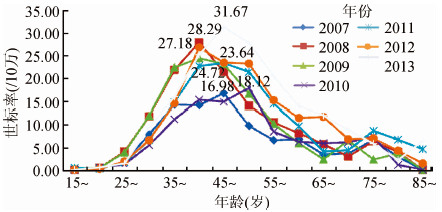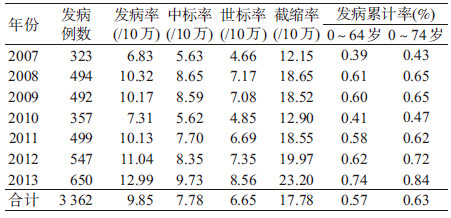文章信息
- 李威, 王德征, 沈成凤, 张颖, 江国虹.
- Li Wei, Wang Dezheng, Shen Chengfeng, Zhang Ying, Jiang Guohong.
- 天津市2007-2013年宫颈癌发病趋势及流行特征分析
- Incidence trends of cervical cancer in Tianjin, 2007-2013
- 中华流行病学杂志, 2016, 37(5): 699-701
- Chinese Journal of Epidemiology, 2016, 37(5): 699-701
- http://dx.doi.org/10.3760/cma.j.issn.0254-6450.2016.05.023
-
文章历史
- 投稿日期: 2015-11-17
宫颈癌是常见的妇科恶性肿瘤之一[1]。我国宫颈癌新发病例占世界新发病例总数的11.7%[2]。《2012年中国肿瘤登记年报》显示,2009年我国城市肿瘤登记地区宫颈癌发病率在女性肿瘤中位居第6位[3],已由2006年的6.04/10万[4]增至2009年的7.58/10万[3]。本研究通过2007-2013年天津市户籍人群宫颈癌发病数据分析其发病趋势。
资料与方法1. 资料来源:天津市肿瘤发病登记监测系统中2007-2013年天津市户籍人口中所有宫颈癌患者,疾病编码参照国际疾病分类(ICD-10)编码为C53.0、C53.1、C53.8、C53.9,人口资料来源于天津市公安局。
2. 统计学分析:用Access 2003软件建立数据库,按照《中国肿瘤登记工作指导手册》推荐方法,采用SPSS 21.0软件计算发病率、年龄别发病率、中国人口标化率(中标率)、世界人口标化率(世标率)等指标,中标率的计算采用2000年中国人口构成,世标率的计算采用Segi’s世界标准人口构成。采用Joint Regression Program 4.0.0.2软件计算年度变化百分比(APC)及其95%CI,分析宫颈癌发病趋势。
结果1. 一般情况:2007-2013年天津市宫颈癌新发病例3 362例,发病年龄为18~91(48.11±10.68)岁,各年度平均发病年龄呈升高趋势(F=17.48,P=0.000),城市地区人群(F=16.52,P=0.000)及农村地区人群(F=4.46,P=0.000)与整体平均发病年龄趋势一致(图 1)。
 |
| 图 1 2007-2013年天津市城乡地区人群宫颈癌发病年龄分布 |
2. 发病年龄构成:2007-2013年宫颈癌患者中15~34岁组占7.91%,35~59岁组占79.51%,≥60岁组占12.58%。7年间15~34岁组构成呈现下降趋势;35~59岁组构成有先升高后下降的趋势,≥60岁组构成呈现上升趋势,但变化差异均无统计学意义(表 1)。
3. 年龄别发病率:2007-2013年天津市宫颈癌的各年龄别发病率相差较大。15~39岁组年龄别发病率随年龄的增长而快速上升;40~44岁组发病率达到高峰,发病率为22.52/10万;45~69岁组年龄别发病率随年龄增长而下降;65~69岁组发病率降至低谷;70岁组后年龄别发病率又随年龄的增长而逐步升高,至75~79岁组达到发病小高峰,80岁组后发病率稍有下降。2007年和2013年发病率高峰出现在45~49岁年龄组(16.98/10万和31.67/10万),其他年份的发病高峰均出现在40~44岁年龄组。随后宫颈癌发病呈现下降趋势,除了2009年和2013年外,其余年份均在75~79岁出现轻微的上升趋势,见图 2。
 |
| 图 2 2007-2013年天津市宫颈癌年龄别发病率 |
4. 发病趋势:2007-2013年天津市宫颈癌发病在城乡中分布情况见表 2。城市地区人群整体发病构成高于农村地区,但从分布可以看出,城市地区人群发病构成呈逐年下降的趋势(趋势 χ2=21.92,P=0.001),而农村地区发病构成则呈现上升趋势(趋势 χ2=12.70,P=0.048),且变化差异均有统计学意义。2007-2013年天津市宫颈癌的平均发病率为9.85/10万,中标率、世标率分别为7.78/10万、6.65/10万。其中宫颈癌发病世标率最低为2007年(4.66/10万),最高为2013年(8.56/10万),各年份的情况见表 3。2007-2013年天津市宫颈癌发病率总体保持平稳,APC值为6.71%(95%CI:-2.9%~17.3%),差异无统计学意义(Z=1.775,P=0.136)。城市地区宫颈癌发病率总体保持平稳,APC值为2.7%(95%CI: -9.1%~16.2%),差异无统计学意义(Z=0.564,P=0.597);农村地区的发病率则呈现上升趋势,APC值为13.4%(95%CI:3.5%~24.2%),差异有统计学意义(Z=3.549,P<0. 016),见图 3。
 |
| 图 3 2007-2013年天津市城乡地区宫颈癌发病趋势 |
2007-2013年天津市宫颈癌的平均发病率为6.65/10万,低于2009年我国平均水平(8.98/10万)[5]。虽然天津市也在重点人群开展过宫颈癌筛查项目,但2007-2013年发病率未出现下降,可能主要与不健康的生活方式,如吸烟率升高、体力活动比例下降有关;此外,不安全性行为也会增加高危型人乳头瘤病毒(HPV)感染的风险。
农村地区的发病率呈现增长趋势(APC值为13.4%)非常值得关注。主要原因可能为2009年以来在全市范围内实施了农村地区妇女宫颈癌筛查[6],提高了农村地区女性宫颈癌的检出率,使其发病率呈现升高的趋势。
40~49岁和75~79岁是天津市宫颈癌高发的年龄段,这与天津市HPV感染率的年龄分布有关,田立慧和于德亮[7]的研究显示,天津市30~40岁女性HPV检出率最高,而感染后需要经10~20年才能转变为宫颈癌。这也是宫颈癌高发的年龄较HPV感染高发年龄推后10年的主要原因。
本研究存在局限性。在2007-2013年未对肿瘤发病登记数据进行漏报调查,不能完全确定发病数量的增多与登记数据的质量提高、漏报率减少是否有关。但是2010-2012年天津市肿瘤发病及死亡数据已纳入2015年国家肿瘤登记年报,2008-2012年肿瘤死亡/发病比(M/I)为0.58,病理诊断所占百分比为63.49%,诊断不明比例为0。提示数据质量较好。
综上所述,天津市宫颈癌发病率未出现下降趋势,宫颈癌仍严重危害着女性的健康,疾病预防控制机构应针对重点人群开展健康教育、早期筛查等预防的宫颈癌和恶变[8, 9]。根据分析结果,尤其需要关注农村地区宫颈癌的流行趋势,应对农村地区女性持续开展宫颈癌筛查,同时应将全市范围的宫颈癌筛查年龄提至35岁以前。
利益冲突 无
| [1] Arbyn M,Castellsagué X,de Sanjosé S,et al. Worldwide burden of cervical cancer in 2008[J]. Ann Oncol,2011,22(12):2675-2686. DOI:10.1093/annonc/mdr015. |
| [2] World Health Organization. Globocan 2012:estimated cancer incidence,mortality and prevalence worldwide in 2012[EB/OL]. (2015-02-02)[2015-08-24]. http://globocan.iarc.fr/Pages/fact_sheets_cancer.aspx?cancer=cervix. |
| [3] 赫捷,陈万青. 2012中国肿瘤登记年报[M]. 北京:军事医学科学出版社,2012. Hao J,Chen WQ. 2012 Chinese cancer registry annual report[M]. Beijing:Military Medical Science Press,2012. |
| [4] 赵平,陈万青. 2009中国肿瘤登记年报[M]. 北京:军事医学科学出版社,2010. Zhao P,Chen WQ. 2009 Chinese cancer registry annual report[M]. Beijing:Military Medical Science Press,2010. |
| [5] 乔友林,赵宇倩. 宫颈癌的流行病学现状和预防[J]. 中华妇幼临床医学杂志:电子版,2015,11(2):1-6. DOI:10.3877/cma.j.issn.1673-5250.2015.02.001. Qiao YL,Zhao YQ. Epidemiology and prevention of cervical cancer[J]. Chin J Obstet Gynecal Pegiatr:Electron Ed,2015,11(2):1-6. DOI:10.3877/cma.j.issn.1673-5250.2015.02.001. |
| [6] 天津市人民政府. 批转市卫生局拟定的天津市妇女儿童健康行动计划(2008-2012年)的通知[J]. 天津市人民政府公报,2008(12):2-4. Tianjin Municipal People's Government. Notice about the planning for women's and children's health in Tianjin formulated by Tianjin public health bureau[J]. Tianjin Municipal People's Government Bulletin,2008(12):2-4. |
| [7] 田立慧,于德亮. 2009-2011年天津渤海地区妇女HPV普查结果分析[J]. 中国妇幼保健,2013,28(1):53-54. Tian LH,Yu DL. Analysis about general survey of HPV in women from 2009 to 2011 in Bohai area,Tianjin[J]. Matern Child Health Care Chin,2013,28(1):53-54. |
| [8] Brabin L,Roberts SA,Farzaneh F,et al. Future acceptance of adolescent human papillomavirus vaccination:a survey of parental attitudes[J]. Vaccine,2006,24(16):3087-3094. DOI:10.1016/j.vaccine.2006.01.048. |
| [9] Levi F,La Vecchia C,Randimbison L,et al. Incidence,mortality and survival from invasive cervical cancer in Vaud,Switzerland,1974-1991[J]. Ann Oncol,1994,5(8):747-752. |
 2016, Vol. 37
2016, Vol. 37





